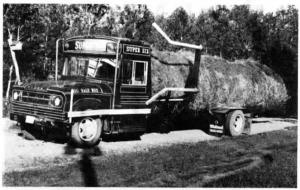1989 - Volume #13, Issue #3, Page #07
[ Sample Stories From This Issue | List of All Stories In This Issue | Print this story
| Read this issue]
Super Six Big Bale Bus
 |
Keep and Sich built the "Super Six" after reading a FARM SHOW article on another self-propelled bale bus made by Scott Miles, of New Richmond, Ind. (Vol. 5, No. 1). "We've used our bale bus for seven years now and it has more than paid for itself, replacing a tractor and front-end loader. It makes picking bales up on-the-go quick and easy, and it makes hauling them more of a pleasure than a chore. It also speeds up bale hauling. We routinely pick bales up in the field traveling 3 to 5 mph without stopping, and we can move six bales down the road at 55 mph. It works so slick that my wife does most of the bale hauling and the kids ride with her," says Keep.
The men built the "bale bus" by removing everything except for the front portion of the bus and the 30 1/2-ft. long frame. They unbolted the rear 2-ft. section of the bus body (the bus was built in 2-ft. sections), moved it forward and rebolted it to the front part of the body to form a cab. They then mounted the bale-moving conveyor chain and rails from an old pull-type bale wagon on the rear frame. The chain is powered by a hydraulic motor. Next they installed a 4 by 8-in. hydraulic cylinder to power the home-built bale pickup arm, which is equipped with two 5 1/2-ft. long prongs spaced 4 ft. apart. The prongs, made from 3 1/2-in. oil drilling pipe, are tapered upward to cradle the bale. A bale guide which consists of a 4-in. wide length of flat iron runs from the front bumper to the rear of the cab to guide bales onto the pickup arm. They also built a dual muffler and rerouted it above the cab to keep chaff from landing on the muffler and catching fire.
A 3-ft. high, 5-ft. long railing mounted opposite the hydraulic arm keeps bales from falling off the other side of the frame as they're loaded.
"We haul a single row of bales, but by widening the frame and installing a double set of tracks and conveyor chains we could haul a double row of bales," notes Keep. "Our hydraulic arm has enough power to throw bales to a second track so we wouldn't need a second hydraulic arm. The first row of bales would act as a bumper for bales coming off the lift arm.
"If we could do it over again, we'd move the track and conveyor chain back 2 ft. from the cab to provide extra carrying room. If we hit rough ground when carrying six bales we sometimes lose the rear one."
Keep says he and Sick spent about $5,000 to build the bale bus.
Contact: FARM SHOW Followup, Robert Keep, Box 43, Punnichy, Sask., Canada S0A 3C0 (ph 306 835-2880).

Click here to download page story appeared in.

Click here to read entire issue
To read the rest of this story, download this issue below or click here to register with your account number.




